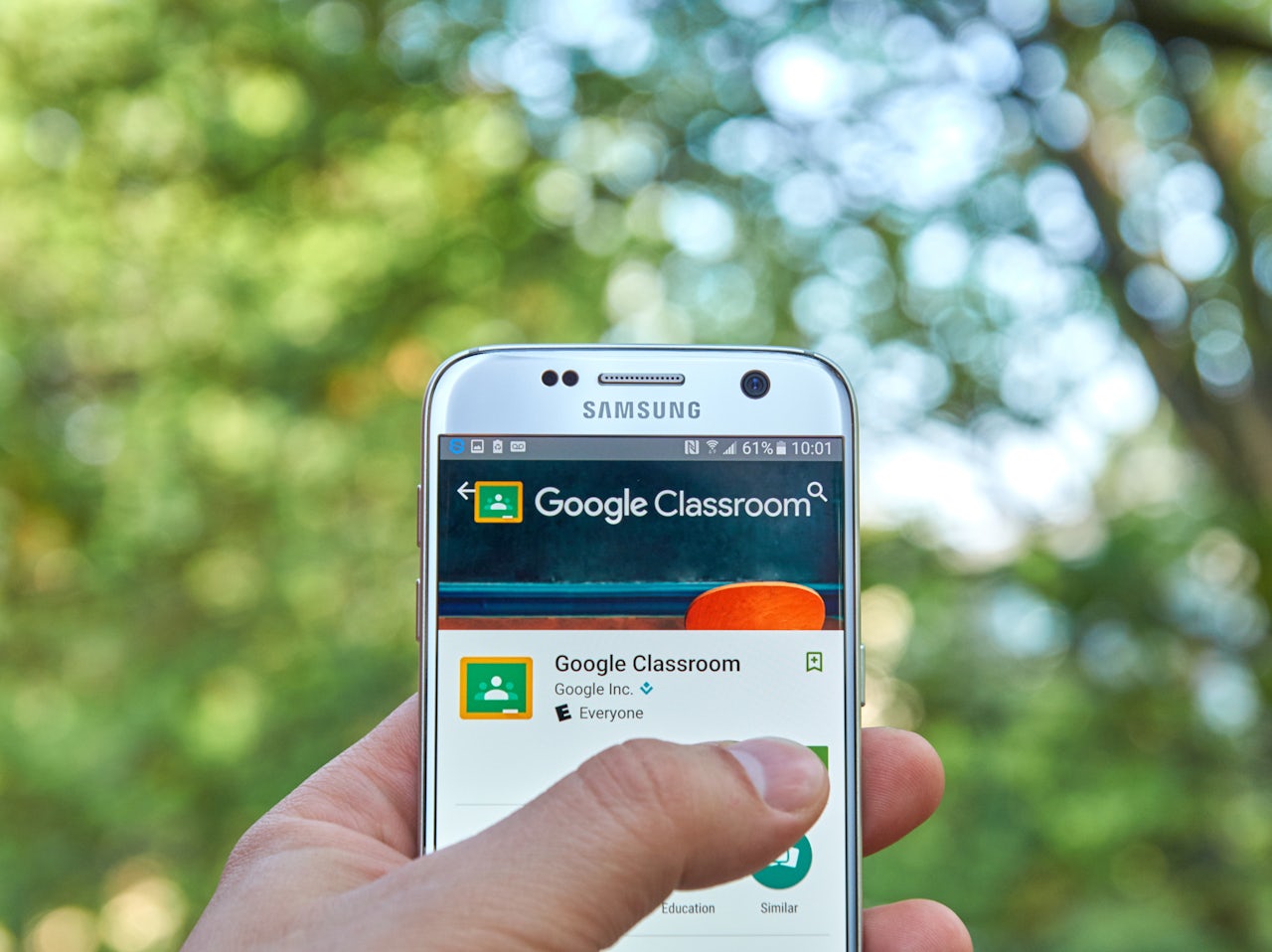The video game Interland is part of Google's “Be Internet Awesome” curriculum aimed a “helping kids be safe, confident explorers of the online world.” It’s set in a dreamy, blandly futuristic landscape rendered in the four hues of the Google logo. Numbing music cycles endlessly, like a shopping mall visit on a large dose of Klonopin. A cute avatar called an Internaut — an Android logo, thinly disguised — advances when the player correctly answers questions about oversharing, cyberbullying, and phishing scams.
The game’s release was met with positive reviews that completely miss the point. Interland may be fun and appealing, and may even serve a pedagogical purpose when it comes to drilling kids to recognize scammy or inappropriate online behavior. But even though there’s nothing to buy, Interland is an ad. It doesn’t hawk junk food or sneakers; rather Interland sells to kids the message that Google is a trustworthy arbiter of online safety and privacy. And Interland is only one of many ways this message has become increasingly embedded in K-12 school classrooms.
According to a representative for the company, 25 million students worldwide use Chromebooks at school, which are generally more affordable alternatives to fully-fledged PCs or Macs. More than 80 million people use G Suite for Education, with 30 million teachers and students using Google Classroom, a management app that allows teachers to push out assignments and materials and collect student work. Companies selling products for schools to place in student hands is neither new nor, in itself, cause for concern. There is, however, an important difference between companies in the mold of, say, Houghton-Mifflin as opposed to one like Google.
The former, presumably, is not trying to nurture cradle-to-grave consumers of social studies textbooks. The latter has a very strong interest not only in training the workforce of the future in G Suite, but also in forming positive and powerful brand associations in the minds of its littlest consumers.
To get a sense of what all this brand exposure looks like, just spend an hour in my middle school classroom. On a typical day, students start class with a warm-up activity posted on Google Classroom. After we go over their answers and I teach a lesson, I might direct my students to open Google Docs and start writing. “Remember to check Google Calendar and start studying for your next quiz! Oh, and don’t forget to turn in your writing on Google Classroom before Thursday!” I holler into the void as they pack up their bags. I’ve learned from experience that I need to specify “Google Classroom” every time I give this direction; if I don’t, if I just say "Classroom," some students will submit their work on Classroom, some will stick it in their lowercase-c classroom notebooks, and at least one person will wander around the actual classroom while I am in the middle of an explanation, assignment in hand, wondering aloud where he was supposed to turn it in.
Kids learn both explicit and implicit lessons at school. A school can hang a banner to celebrate diversity, for instance, but if students encounter few people of color on the syllabus and in positions of authority in the school, they are likely to learn diversity doesn’t really matter even with its importance spelled out in foot-high letters. Beyond datamining, some parents and privacy advocates have expressed concern that even when kids are explicitly taught how to safeguard their personal information online, school-mandated Chromebooks and Google accounts implicitly train kids to accept surveillance and hand over personal information. At the very least, how Google’s presence and presentation in schools is shaping children’s attitudes towards the company is a topic that deserves more scrutiny than it has received in an educational moment that prizes all things STEM and tends to herald technology in the classroom as an unalloyed good.
From one vantage point, classrooms like mine look like education technology success stories, with students’ academic learning seamlessly interwoven with the workflow habits and productivity apps of all tomorrow’s office workers. Using Google products, students can work collaboratively on files, use the internet for research, and acquire competency with the basics of personal computing. Districts often save substantial amounts of money by using Google’s services in place of their own email servers and can provide more classroom access to computers using Chromebooks than they could using pricier alternatives. In a country where public education is cruelly underfunded, there’s no mystery as to why teachers and districts are drawn to Google's cheap, often free, education technology and curriculum, but there needs to be an honest reckoning of its real price tag and robust public discussion about whether that is a cost worth paying.
As the recent scrutiny of Facebook and Cambridge Analytica reminds us, placing tremendous faith in and few restrictions on powerful technology companies can have consequences that are difficult for users to grapple with until after serious damage is done. This is especially true of companies like Facebook and Google that possess tremendous amounts of our personal data and shape what information we see, all while deriving profit from ads. Google does not serve ads to K-12 student users on core G Suite for Education services, though it does collect and retain their data. If students eventually transfer the contents of their school Drive account to a personal Drive account, as they are often prompted to do before they graduate so they don’t lose all record of their work, the information they created in school as a minor is no longer treated with special protections.
The bulletin-board like interface of Classroom all share a peppy kindergarten aesthetic that blurs the distinction between the school and the company.
Product placement on film, TV, and social media works because it capitalizes on our pre-existing affections and associations. Picture the elementary school classroom you loved best as a child: bulletin boards covered in primary-colored construction paper; displays labeled with the same die-cut, sans-serif paper letters used by every teacher in America. Did it sort of resemble, in a general way, the look of Google’s logo? That logo, the childlike Google Doodles, the bulletin-board like interface of Classroom all share a peppy kindergarten aesthetic that blurs the distinction between the school and the company in a way that is perhaps visually pleasing but also imparts unearned to Google the positive associations that we hope children have for teachers and their school: feelings of safety, trustworthiness, care, and authority.
The irony of a curriculum that teaches kids how to safeguard their privacy online yet is produced by a company known for its less-than-transparent use of personal data is a little on the nose, but the explicit lessons in Be Internet Awesome are too basic to be objectionable. The fundamentals of awesomeness, according to the program, include accounting for personal risk and propriety when posting online (“Share with Care”), recognizing scams (“Don’t Fall for Fake”), setting strong passwords (“Secure Your Secrets”), opposing online bullying (“It’s Cool to Be Kind,” whose Nick Lowe reference is wasted on the young), and recognizing when to go to a trusted adult (“When in Doubt, Talk it Out”). Pragmatic as the content is, it also transmits implicit lessons about the Google brand, whose brand colors, icons, and font are slathered over everything from student handouts to classroom posters to, for some reason, paper doll patterns for making your very own Internaut.
Be Internet Awesome implicitly signals to students that Google is synonymous with privacy and safety. By focusing solely on personal choices, the program suggests that the power to protect personal information lies entirely within one’s own hands and locates responsibility for doing so with the individual. There’s nothing wrong with telling students not to send money to someone claiming to be a Nigerian prince but for most people, most of the time, there is greater danger in all the usual and perfectly legal ways of persuading us to part with our money, just as the greater threat to our privacy, as anyone compromised in the Experian hack can tell you, comes not from, or not only from, crappy passwords but from numerous ways we are tracked without our permission or knowledge. If a goal, ultimately, is not just to prevent kids from downloading viruses onto school devices but to teach them how to protect themselves from larger corporate interests that may use them for their data, classroom materials that subtly advance a particular narrative about the company that made them undermine that end.
Interland is especially egregious, meeting the criteria for what Common Sense Media, in its 2014 research paper, terms an ‘advergame,’ an online game that “involves a user playing with branded items. . . or playing in a heavily branded environment.” Advergames are psychologically powerful because they “involve the child for a longer period of time than TV ads do, and the experience of playing the game is more immersive and may promote identification with the product.” Additionally, “by their very nature, advergames blur the boundaries between entertainment and advertising content. . . [and] the mental state of flow some gamers get into while playing also may contribute to a blurring of boundaries.”
Many school children, especially early elementary-school aged ones, are yet to reach the stage of development where they are able to recognize the motivations of other people, let alone understand why an abstract corporate entity might have an interest in portraying itself in a particular way. Young kids can’t recognize ads as such; even adolescents are not attuned to rhetoric and manipulation in the same way as adults and need instruction in this area. This, of course, as any parent who has ever raced a cart down the cereal aisle knows, is what makes kids such a credible, vulnerable, and lucrative audience.
As the saying goes, if you are not paying for the service you’re using, the product is you — your personal information, your attention, or, in this case, your children’s. None of this is to say that Google’s classroom technology is not a useful tool. It can provide new avenues for educators and students to research, collaborate, and make real-world connections. Even the Be Internet Awesome curriculum speaks to a real need schools have to prepare students for life in a digital world though they lack resources, including teacher expertise, to do so. The issue isn’t that Google has nothing of value to offer schools — clearly, it has — but rather at what price are we buying it. If it’s too steep we might want to recall lessons from our own educations, not about how to be savvy, polished consumers of technology, but about how to be citizens.


